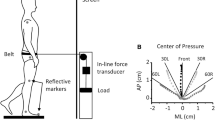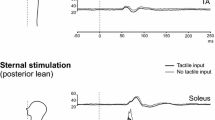Abstract.
It is unknown to what extent automatic postural responses are triggered by lower leg proprioception. This issue was addressed by studying postural control in five carefully selected patients with subtle diabetic polyneuropathy (restricted to the lower legs) and 15 healthy subjects. All patients had bilaterally absent Achilles tendon reflexes and weak or absent patella tendon reflexes, but muscle strength was fully preserved. Subjects were tested while standing on a supporting, movable force-plate. The contribution of lower leg proprioception to automatic postural responses was investigated by randomly exposing the subjects to either a 4° 'toe-up' rotational perturbation ('normal ankle input'), a simultaneous 4-cm rearward translation and 4° toe-up rotation ('enhanced ankle input'), or a simultaneous 4-cm rearward translation and 4° 'toe-down' rotation ('nulled ankle input'). We recorded surface EMG (stretch reflexes and balance-correcting responses) from leg and trunk muscles, ankle torque and angular velocities of the upper and lower legs and trunk. We argued that automatic postural responses that have abnormally small amplitudes in patients and are modulated in controls with the velocity of different types of ankle rotations must receive a major input from lower leg proprioception. Conversely, automatic postural responses that are weakly modified in amplitude or onset by different ankle perturbations and are present despite nulled ankle inputs and, finally, are unaffected in patients with distal polyneuropathy must be triggered or modulated by inputs other than from lower leg proprioception. Normal postural synergies and strategies were maintained in patients, although within a given synergy the timing and amplitude of some automatic postural responses were abnormal. A few automatic postural responses appeared to be triggered or modulated by lower leg proprioception. Thus, early stretch reflexes in soleus and medial gastrocnemius were severely diminished in patients, while in controls these stretch reflexes were modulated by different ankle perturbations. Furthermore, balance-correcting responses in tibialis anterior were diminished and delayed in patients, while in controls these balance-correcting responses were modulated by different ankle perturbations. Other automatic postural responses were apparently not triggered or modulated by lower leg proprioception, but likely received a major input from more proximal sensory systems. Thus, in both groups prominent balance-correcting responses were present in several muscles (soleus, gastrocnemius, quadriceps, paraspinals and trapezius) during the 'nulled ankle input' condition, where ankle position was stabilised over the first 250 ms. During the 'enhanced ankle input' condition, where prominent ankle dorsiflexion occurred during the first 200 ms, amplitudes of balance-correcting responses were only marginally weaker in patients than in controls. We analysed body segment displacements to unveil the potential nature of proximal triggers for automatic postural responses. As opposed to the 'inverted pendulum' concept of postural control, early movement occurred in the knees, hips and trunk well before the onset of automatic postural responses. For example, during the 'nulled ankle input' condition, the lower leg moved forward with early knee flexion, followed by knee extension. The trunk extended backwards at 80 ms, which was followed by forward flexion. The absent stretch reflex and weaker balance-correcting responses in patients produced changed trunk velocity profiles (mainly a reduced initial backward motion of the trunk), but lower-body segment movements showed no consistent differences between the two groups. Considering these body segment displacements, any automatic postural response with an onset within the first 200 ms could well be triggered by receptors located at the knee, hip or trunk. These results indicate that most balance-correcting responses are not triggered by lower leg proprioception. We speculate that lower leg inputs are mainly used to trigger some lower leg automatic postural responses when knee movements are small, as occurs with the commonly used toe-up rotational perturbations. Under other circumstances, lower leg inputs act mainly to modulate automatic postural responses, once these have been triggered by more proximal inputs within the upper legs or the trunk. In the absence of this modulation, trunk movements are changed.
Similar content being viewed by others
Author information
Authors and Affiliations
Additional information
Electronic Publication
Rights and permissions
About this article
Cite this article
Bloem, B., Allum, J., Carpenter, M. et al. Is lower leg proprioception essential for triggering human automatic postural responses?. Exp Brain Res 130, 375–391 (2000). https://doi.org/10.1007/s002219900259
Received:
Accepted:
Published:
Issue Date:
DOI: https://doi.org/10.1007/s002219900259




